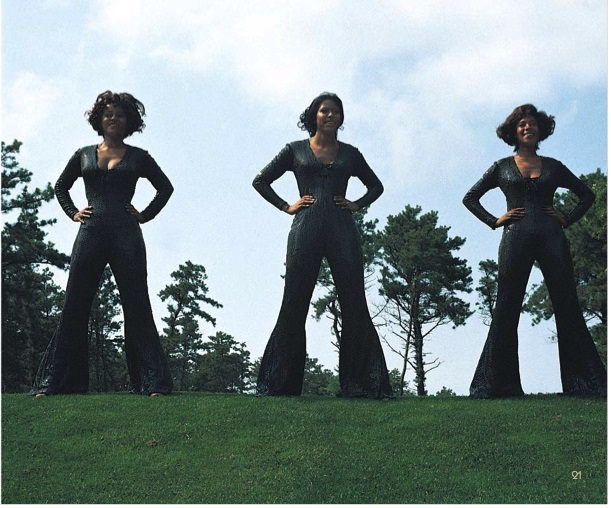THE SUPREMES
 High on a hill: Cindy Birdsong, Jean Terrell, Mary Wilson
High on a hill: Cindy Birdsong, Jean Terrell, Mary Wilson
- When Diana Ross left the Supremes, Motown executive Michael Roshkind publicised the change as a “two-for-one stock split.” The line was even picked up by TV maestro Ed Sullivan as Diana, Mary Wilson and Cindy Birdsong prepared on Jan. 14, 1970 for their final concerts together. “As of tonight,” Sullivan declared, “one of the greatest attractions of the ’60s becomes two of the greatest attractions of the ’70s.” By the time that Cindy, Mary and Jean Terrell were photographed above – in a rarely seen shot believed to have been taken in 1971 – their “stock” was hot. The group had scored two Top 10 pop hits and a further two Top 20 successes (including a duet with the Four Tops, “River Deep – Mountain High”) as well as a Top 5 album on the R&B charts. The “new” Supremes were performing well in foreign stock markets, too: “Up The Ladder To The Roof” and “Stoned Love” were Top 10 chart-breakers in the U.K. during 1970-71, for example, and their duet album with the Tops, The Magnificent 7, was a Top 10 seller there.
- Jean, Mary and Cindy were raising the roof in concert, too, as the Supremes’ “brand” continued to prosper. On March 11, 1971, they played in the Detroit area for the first time since that “two-for-one stock split.” The trio’s show at the Elmwood Casino in Windsor, across the Detroit River in Canada, was a major success, spurred on by a strong Motown audience presence that night, including Berry Gordy, Smokey and Claudette Robinson, and ex-Supreme Florence Ballard. “One of the things that has surprised most veteran Supremes-watchers during their current run at the Elmwood,” wrote columnist Bob Talbert in the Detroit Free Press, “is how bright, outspoken and charming the formerly retiring Mary Wilson, the original Supreme, has become. Don’t look for her to be a Diana Ross-leader type, but she is her own girl.” Talbert concluded, “The Supremes are truly a ‘group’ again.”
- Ten years earlier, such circumstances would have been unimaginable to the three young women. Mary officially joined Motown in January 1961, when she, Diana, Flo and Barbara Martin signed their recording contracts, and it would be another three years before the Supremes began to get seriously noticed beyond Detroit. Cindy Birdsong in ’61 was not yet a member of the Philadelphia group which came to be known as the Blue Belles, from which she eventually came to replace Florence in the Supremes. And Jean in 1961 was even further away from celebrity: her experience of fame at that stage derived mostly from being the younger sister of up-and-coming boxing star Ernie Terrell. (Later, Jean and Ernie sang together, which was how she came to Berry Gordy’s attention.)
- By the time that Cindy, Jean and Mary were pictured, arms akimbo in dark brown outfits on a verdant hilltop in 1971, they were used to photographers and the settings they chose. The trio’s first Motown LP, Right On, featured glamorous images shot by Frank Dandridge. Among other Supremes snappers of the decade were Harry Langdon, whose work adorned the cover of the Touch album, and Larry Raphael, who took the photos used for New Ways But Love Stays. Later, Mary, Jean and Cindy were photographed in Los Angeles by Jim Britt, whose work for Motown there extended to almost all its 1970s roster.





